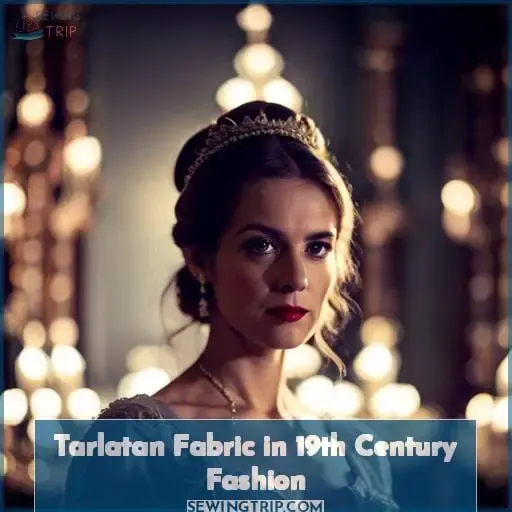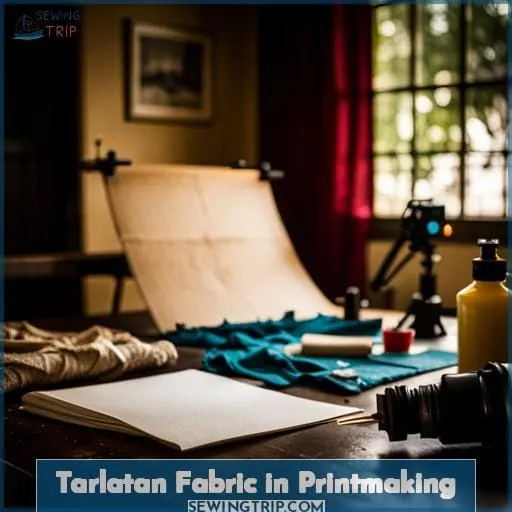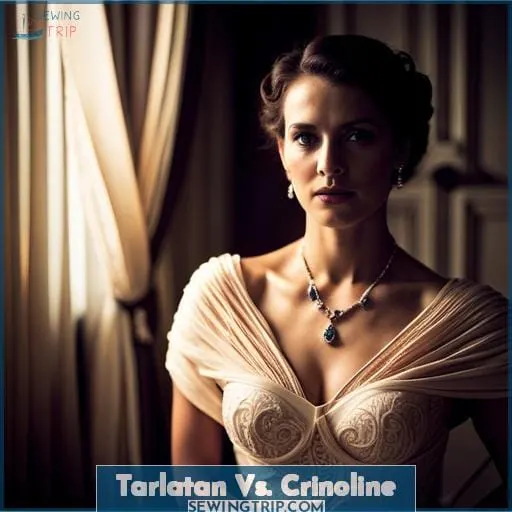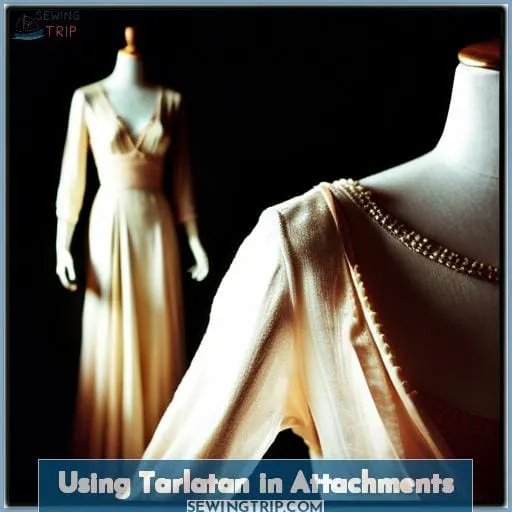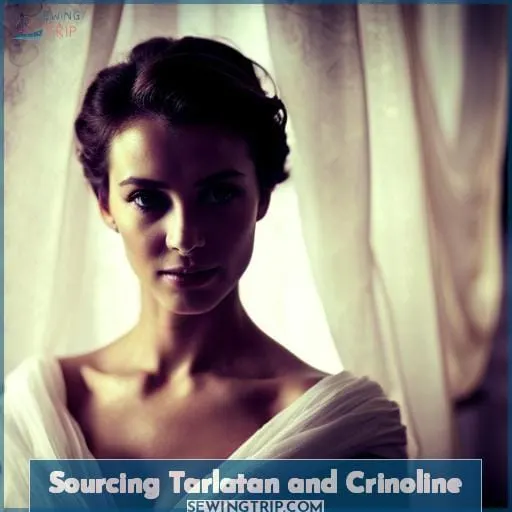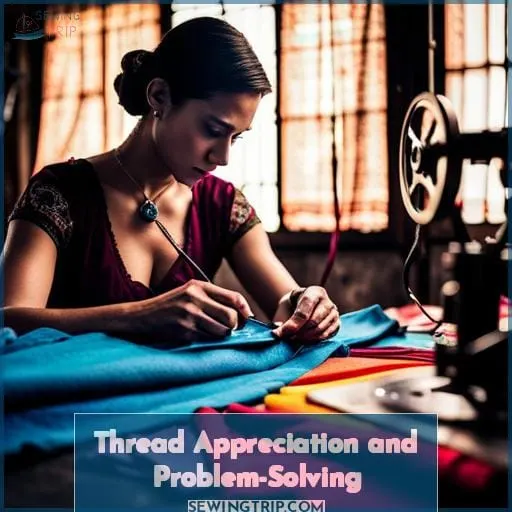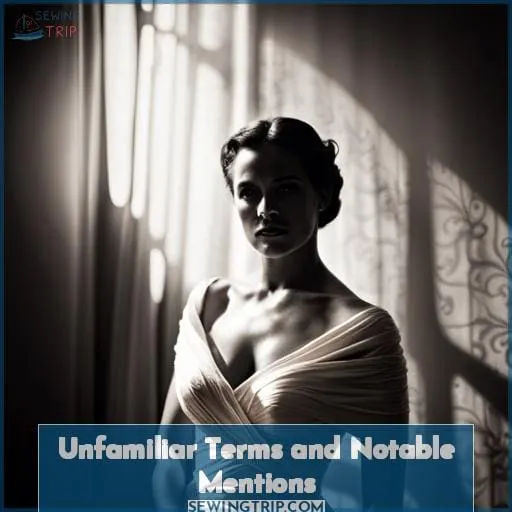This site is supported by our readers. We may earn a commission, at no cost to you, if you purchase through links.
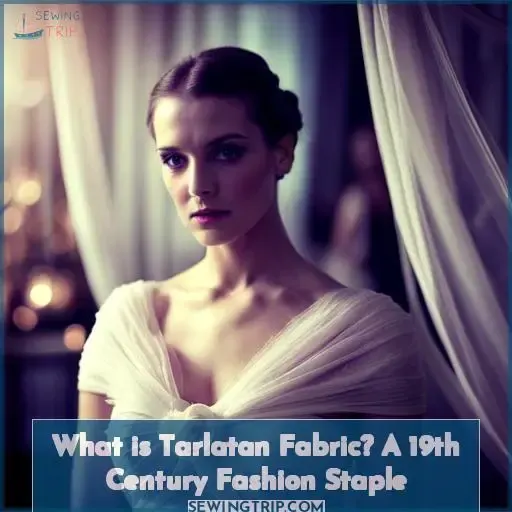 Have you ever wondered about those billowing dresses in 19th-century paintings? The secret to their volume lies in tarlatan fabric. Though you may not have heard of it, this stiff, cheesecloth-like material was essential for creating the iconic silhouettes of the era.
Have you ever wondered about those billowing dresses in 19th-century paintings? The secret to their volume lies in tarlatan fabric. Though you may not have heard of it, this stiff, cheesecloth-like material was essential for creating the iconic silhouettes of the era.
Let’s journey back in time and discover how tarlatan shook up fashion with its crisp texture and sheer appearance. From ballgowns to petticoats, we’ll see how this fabric dominated early Victorian style.
Understanding tarlatan’s origins will help you appreciate its influence on dress and society.
Join me as we unpack the past through the lens of this forgotten textile that gave shape to historic fashions.
Table Of Contents
- Key Takeaways
- What is Tarlatan Fabric?
- Tarlatan Fabric in 19th Century Fashion
- Tarlatan Fabric in Printmaking
- Tarlatan Vs. Crinoline
- Using Tarlatan in Attachments
- Sourcing Tarlatan and Crinoline
- Exploring Vintage Attachments
- Thread Appreciation and Problem-Solving
- Unfamiliar Terms and Notable Mentions
- Frequently Asked Questions (FAQs)
- Conclusion
Key Takeaways
- Tarlatan fabric was used in 19th-century dresses to provide volume and structure without the need for hoops or crinolines.
- It fell out of favor but has found renewed purpose in artwork overlays, costumes, and vintage sewing.
- Tarlatan is lightweight and durable, making it perfect for colorful prints and trims in dresses, petticoats, and home décor.
- It can be cleaned by gently handwashing with mild soap and air drying.
What is Tarlatan Fabric?
Tarlatan, an open-weave cotton fabric stiffened for shape, was a vibrantly-colored material popular for summer dresses in the 1860s before declining by the 1870s. The stiff yet sheer fabric provided structure without the need for hoops or crinolines underneath.
Though originally trimmed with bright ribbons and lace, tarlatan’s bold hues soon fell from favor as fashions shifted. Yet even as it faded from ballgowns, tarlatan found renewed purpose as an overlay for artwork and costumes.
Comparing tarlatan to fabrics like crinoline reveals insights into historical trends.
Whether providing inspiration or a sturdy base layer, tarlatan’s legacy continues to shape creative projects today.
Tarlatan Fabric in 19th Century Fashion
Let’s talk Tarlatan and its prime properties for p■-up petticoats. This light, airy cotton weave came in vivid colors on a white background and shaped the billowy gowns of the 1860s without the bulk of old-fashioned hoops or crinoline.
Compared to the shimmering silks of the era, Tarlatan brought a casual silhouette in need of plenty of frilly trim.
Characteristics of Tarlatan Fabric
You’ll love working with this lightweight, open-weave cotton fabric that’s been stiffened to help skirts hold their shape. For example, a historical costumer might use it when recreating the vibrantly colored and intricately trimmed dresses that were so popular in the 1860s.
Tarlatan’s thin yet durable weave makes it an ideal base for colorful prints and trims. Though crinoline eventually replaced it, tarlatan’s cost and accessibility ensured its ongoing use in petticoats and home décor.
Popular Uses in Fashion
You’d find Tarlatan fabric ideal for making vibrantly colored 1860s dresses without needing hoops or crinoline to hold their shape. Its innovative styling allowed young girls to embrace the freedom of movement while radiating a sense of power and liberation.
Through colorful variations and skilled fabric manipulation, 19th-century sewers created garments that exuded a unique charm. This vintage fashion revival not only celebrated the past but also showcased the artistry of period accessories and the strength imbued by the cotton thread grid used for stiffening and strengthening garments.
Comparison to Other Fabrics
Explore the vibrant world of 19th-century fashion, where thin open-weave cotton transformed into artful creations that hinted at the rise of the bustle and shaped the way summer wear danced without hoops or crinoline.
Amidst the array of textiles, tarlatan stood distinct, its open weave like a canvas for vibrant hues. This cotton marvel also found purpose in the printing industry, its weave capturing ink while gracing costumes and disposable items.
Starch application, a key step, lent tarlatan its stiffness, setting it apart from other textiles.
Tarlatan Fabric in Printmaking
Delving into the realm of printmaking, you’ll find that tarlatan fabric emerges as an intriguing player. Its distinct characteristics, including an open-weave structure crafted from woven cotton, render it a favorite in printmaking circles.
This fabric adeptly captures printer’s ink, leading to its widespread use for cleaning plates and reinforcing other garments. Careful consideration must be given to maintenance, as washing might inadvertently remove the starch that grants tarlatan its defining stiffness.
Characteristics of Tarlatan Fabric in Printmaking
Immerse yourself in the world of printmaking as you discover the captivating characteristics of tarlatan fabric. Its open-weave structure proves ideal for printmaking applications, adeptly absorbing ink while aiding in plate cleaning.
Through a meticulous stiffening process, this versatile material gains the perfect blend of rigidity and flexibility. Employing layering techniques enhances its ink-trapping abilities. Tarlatan fabric’s historical roots as a printmaker’s ally reflect its enduring significance in the craft.
Popular Uses in Printmaking
You trap printer’s ink like a summer dress flirts with the wind, your open weave eagerly drinking in color only to make its removal a challenge worthy of time itself.
- Hand printing
- Plate preparing
- Cleaning techniques
You spread ink generously, utilize stencils artfully, and bring vibrancy to fabrics in textile-friendly cities. Outlets carry you for costumes, decor, and waistbands. Your stiffened cotton threads offer texture and opportunity.
Cleaning and Care of Tarlatan Fabric
Take care when washing tarlatan fabric, as it may remove the starch that provides stiffness. Gentle handwashing is recommended. Use mild soap and cool water to clean tarlatan. Avoid harsh detergents or hot water that could damage fibers. For stubborn stains, spot treat gently with diluted vinegar or hydrogen peroxide.
Air dry thoroughly after rinsing. Lightly press with a cool iron if needed. Handle tarlatan gently, and it can be a versatile fabric for crafting.
Tarlatan Vs. Crinoline
Let’s talk textiles. Since stiff, open-weave cottons are your favorite, I want to cover the similarities and differences between tarlatan and crinoline fabric. While both were popular in the 1860s for their ability to create shape in dresses without hoops or petticoats, crinoline posed fire risks.
Despite its safety issues, crinoline remains available today for historical costume designs and crafting.
Similarities and Differences Between Tarlatan and Crinoline
Though tarlatan and crinoline share similarities as open-weave stiff fabrics, crinoline poses fire risks while tarlatan’s humble cotton composition avoids such dangers. As I drape yards of tarlatan across a dress form, noting how it holds shape without hoops, I’m mindful of past tragedies caused by flammable crinolines.
Yet we mustn’t blame the tool, only the lack of care around open flames. While synthetic fabrics offer safer substitutes, to abandon history’s textures is to abandon history itself.
Uses and Risks of Crinoline Fabric
While fire risks posed by crinoline fabrics led to their decline, we should appreciate their structural role in shaping historical fashions.
- Crinoline provided shape without restrictive corsets.
- Hoop skirts allowed more freedom of movement.
- Cotton and horsehair reduced fire hazards of earlier linens.
- Washing reduced flammability of starched fabrics.
- We can celebrate crinoline’s liberating spirit while learning from its risks.
By understanding the interplay of safety and style, we honor the artistry of historical fashion.
Using Tarlatan in Attachments
Hello there, friend! Let’s talk a bit about using tarlatan fabric in vintage sewing machine attachments. This open-weave, stiffened cotton was quite useful for tasks like hemstitching. A tarlatan backing provided stability and prevented tunneling as the attachment pierced the fabric.
Though tarlatan can be tricky to source nowadays, materials like waste canvas or organdy make solid substitutes.
Vintage Attachments for Hemstitching
You’ve struggled with mastering that vintage Singer, but don’t lose heart – with some tarlatan backing, you’ll soon be hemstitching like a pro.
| Vintage Attachment | Use | Sourcing |
|---|---|---|
| Singer Hemstitcher | Adds decorative touch | Manuals, online sellers |
| Specialty presser feet | Quilting, embroidery, overlocking | Same |
| Attachments like rufflers | Perfect gathers and ruffles | Garage sales, Etsy |
| Zigzag | Decorative stitches | Vintage shops, sewing groups |
Vintage attachments require some trial and error, but with the right supplies and ambition, their full potential will be unlocked.
Importance of Tarlatan Backing
Adding a Tarlatan Backing enhances your vintage hemstitching results tremendously. This ingenious technique, cherished by aficionados of historical crafting, elevates the finesse of your hemstitching endeavors.
Unveil a world of alternatives for backing – explore sturdy waste canvas or crisp cotton organdy. As you delve into vintage attachment tutorials, grasp the art of attachment cleaning. Embrace material comparison, considering the timeless charm of crinoline as a substitute.
Elevate your mastery of hemstitching techniques and forge a path to creative empowerment.
Alternative Sources for Tarlatan
You can substitute crinoline for tarlatan when sourcing vintage materials for attachments becomes tricky. Consider fiber content and structure when selecting substitutes. Test colorfastness before use.
Compare texture and drape to find the best match. Reference craft videos when preparing vintage fabric for your project.
| Tarlatan | Crinoline |
|---|---|
| Cotton | Cotton, horsehair, linen |
| Open weave | Open weave |
| Stiff | Stiff |
| For costumes | For costumes |
Sourcing vintage fabrics takes creativity. Focus on finding the right structure, texture, and feel.
Sourcing Tarlatan and Crinoline
Hello there! As a costume designer interested in historical textiles, I’m always on the lookout for specialty fabrics like tarlatan. While it can be purchased from retailers like Etsy or Joann’s, you’ll get the best prices and selection through wholesale distributors and bulk purchasing.
An alternative to traditional tarlatan is crinoline fabric, also known as leno, which has a similar stiff, open-weave construction.
Places to Buy Tarlatan Fabric
Have you considered checking craft stores like Joann’s or Etsy for tarlatan fabric? Historic dressmaking demands access to specialty textiles like this open-weave cotton. Seek it out for your next costume craft event or vintage textile exhibition while supporting textile conservation efforts and ethical sourcing certifications.
With some effort, you can obtain this historically significant material for your creative pursuits.
Wholesalers and Bulk Purchasing Options
Exploring the realm of wholesale purchasing opens up avenues for acquiring bulk quantities, facilitating large-scale crafting endeavors and historical costume projects. Wholesale suppliers offer an array of tarlatan and crinoline options, allowing you to select the perfect fabric for your creative vision.
Pricing options cater to various budgets, and quantity discounts sweeten the deal. The diverse variety of suppliers empowers you to choose the ideal materials for your designs, providing both liberation and creative power.
Crinoline Fabric as an Alternative
Discover an intriguing alternative that gracefully captures the essence of the past – crinoline, a versatile material that opens doors to creative possibilities beyond the expected. Embrace the charm of vintage sewing techniques by incorporating crinoline alternatives into your costume construction endeavors.
This fabric, once hailed for its structural prowess, now offers itself as a contemporary substitute for sourcing tarlatan. Unleash your artistic flair and experiment with fabric stiffening, breathing life into your crafts with a touch of historical allure.
Exploring Vintage Attachments
Delve into the realm of vintage attachments as you embark on a journey to master their intricacies. Discover the fascinating results of test runs using Tarlatan Backing, unraveling a tapestry of techniques that promise to elevate your craft to new heights.
Learning to Use Vintage Attachments
As you delve into using vintage attachments, you grasp the intricacies of mastering these techniques, enhancing your understanding of crafting’s historical roots. Through antique sewing methods, you unlock the secrets of classic stitching, weaving threads that connect the past and present.
Skill enhancement becomes a journey of liberation, granting you the power to breathe life into forgotten patterns.
Test Runs and Results With Tarlatan Backing
In your current phase, delve into the realm of vintage attachments, where your experiments with Tarlatan Backing start to reveal intriguing results. Hemstitching techniques intertwine with improved stitching methods, guided by insights from vintage equipment.
Creative backing approaches provide a new dimension to your attachment experimentation. Unveil the secrets of bygone craftsmanship and watch as your mastery of these techniques blossoms, granting you a newfound sense of liberation and creative power.
Hemstitching Techniques:
Fine-tune stitches with precision, embracing the artistry of delicate details.
Improved Stitching Methods:
Rediscover the finesse of bygone stitches, as vintage equipment inspires your craft.
Attachment Experimentation:
Explore the uncharted territory of attachment experimentation, yielding surprising revelations.
Vintage Equipment Insights:
Vintage attachments offer insights into the intricacies, revealing the secrets to timeless stitching.
Creative Backing Approaches:
Embolden your work with innovative backing strategies, weaving a tapestry of techniques that inspire awe.
Thread Appreciation and Problem-Solving
Delving into the realm of vintage attachments and textile techniques, you find yourself immersed in a vibrant discourse among fellow enthusiasts. Expressions of gratitude flow as members exchange insights, collectively celebrating the woven intricacies of tarlatan fabric.
With an artisanal spirit, they collaboratively unravel the threads of hemstitching challenges, ingeniously problem-solving for finesse in their craft.
Member Discussion and Thankfulness
Engage in the ongoing exchange among members, where thankfulness resonates for insightful conversation that hones techniques and advances your mastery of vintage attachments. Within this creative tapestry, the threads of member techniques interweave, each strand an expression of creative mastery.
Material alternatives, like sturdy crinoline, offer new dimensions to vintage crafting, unlocking unforeseen avenues of creativity. With each shared insight, you thread the needle of skill enhancement, stitching together a vibrant fabric of knowledge and inspiration.
Problem-Solving for Hemstitching Results
Take your hemstitching to the next level by embracing the artistry of thread, unraveling the secrets of vintage attachments, and weaving newfound finesse into your needlework repertoire.
Explore the delicate dance of technique improvement through the wisdom of fellow members. Discover creative alternatives such as Tarlatan Backing, a vintage gem that breathes life into your stitches.
Don’t shy away from seeking attachment mastery; let your stitches tell stories of vintage solutions and unbounded creativity.
| Technique Improvement | Attachment Mastery | Member Insights | Creative Alternatives |
|---|---|---|---|
| Experiment with tension adjustments | Uncover the magic of Singer Hemstitcher | Learn from the community’s journey | Tarlatan Backing: An elegant stabilizer |
| Refine your stitch length and width | Embrace the versatility of the crinoline | Shared experiences and tips | Alternative sources: waste canvas, organdy |
| Explore various stitch patterns | Transform your results with Tarlatan | Overcoming challenges together | Weave history into your creations |
| Test different fabric backings | Harness the power of vintage wisdom | Troubleshooting and triumphs | Let creativity unfurl in your hands |
Unfamiliar Terms and Notable Mentions
Delving into the realm of fabrics and historical attire, one must clarify the intriguing distinction between tarlatan and tartan. While tartan is recognized for its iconic plaid pattern, tarlatan unveils itself as an open-weave cotton fabric, celebrated for its significance in crafting and costume design throughout history.
Clarifying the Difference Between Tarlatan and Tartan
Explore the nuanced differentiation between Tarlatan and Tartan, recognizing their distinct roles in historical craftsmanship and design. Unlike Tarlatan’s open-weave cotton for 19th-century dresses, Tartan is a plaid-patterned fabric.
While Tarlatan finds its place in printmaking and garment reinforcement, Tartan’s cultural significance stems from Scottish heritage. Modern uses range from traditional kilts to contemporary fashion. Understand the intricate weave of textiles, revealing the threads of history and cultural evolution.
Historical Significance of Tarlatan Fabric
Delve into the intricate threads of history, where the vibrant hues of Tarlatan’s delicate canvas once adorned the fashionable dresses of the 1860s, capturing the essence of an era with its unique charm and elegance.
- Craftsmanship Connection: Tarlatan’s open-weave cotton, meticulously stiffened, offered shape and grace.
- Timeless Influence: Popular for 1860s dresses, it shaped summer wear sans crinolines.
- Artistic Legacy: Vibrant colors, ribbons, and lace reflected an era’s spirit.
- Cultural Impact: Printmaking and costumes embraced its sturdiness.
- Valuable Crafting Relic: Tarlatan remains a testament to fashion’s historical tapestry, weaving together threads of creativity and innovation.
Frequently Asked Questions (FAQs)
How did the decline of Tarlatan fabric in the 1870s impact its use for crafting and fashion beyond that era?
Like an ephemeral bloom fading in the twilight, Tarlatan’s decline in the 1870s wove a subtle transformation. Its departure from dresses left a void, but its resilience found new purpose in printmaking, lending strength like a hidden foundation.
What are some specific examples of historical garments or items that were commonly made using Tarlatan fabric aside from dresses?
Discover Tarlatan’s diverse role in history. Beyond dresses, it adorned petticoats, added flair with pleated trims, and shaped summer wear without crinolines. This fabric, once vibrant, still whispers tales of craftsmanship and innovation.
Can Tarlatan fabric be effectively used in contemporary fashion designs, and if so, what are some creative ways to incorporate it?
Unveil the timeless allure of Tarlatan in modern couture. Infuse it with contemporary vigor – fluid overlays, chic interfacing. Merge history’s strength with today’s elegance, weaving liberation and legacy into your designs.
Are there any documented instances of artists or printmakers using Tarlatan fabric in innovative ways beyond its traditional use in printmaking?
Explore Tarlatan’s artistic evolution! Beyond printmaking, visionaries drape it over frames for ethereal installations. Avant-garde fashionistas layer it for unconventional silhouettes. This fabric’s metamorphosis transcends tradition, unveiling boundless creativity.
In the context of using Tarlatan for stabilizing during hemstitching, are there any recommended methods for restoring the stiffness of vintage Tarlatan that may have lost its starch over time?
Reviving vintage Tarlatan’s lost stiffness? Dive into a textile resurrection ritual. Mist lightly with water, sandwich between damp towels, and press with a warm iron.
Conclusion
Like a finely woven tapestry of history, Tarlatan fabric emerges from the 19th century, weaving together its threads of significance. This open-weave cotton is adorned with vibrant hues and trimmed delicately, leaving an indelible mark on fashion.
It was used in dresses, providing shape without cumbersome hoops, and played a role in printmaking, where ink finds both refuge and challenge. Tarlatan’s journey resonates in the realm of vintage attachments, as its backing enhances hemstitching prowess.
Although its popularity waned, its legacy in crafting endures, reminding us that even in the world of fabrics, stories are spun. Uncover the treasure trove of Tarlatan, a key to unlocking the past while igniting creative horizons.

